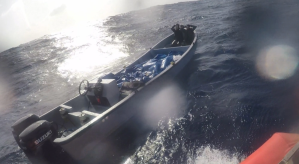DIU moves to accelerate military-enabling batteries, counter supply chain strains

MOFFETT FIELD, Calif. — The Defense Innovation Unit is expanding its energy portfolio to cover a new, third line of effort that’s designed to accelerate commercial battery technologies tailor-made for U.S. military purposes and improve the resilience of the associated domestic supply chain amid heightening competition with China, according to an official steering that work.
“For better or worse, the [Defense Department] has never been very good at batteries. We do bespoke, one-off batteries, historically — and we’re trying to change that,” DIU’s energy portfolio director Andrew Higier told a small group of reporters last week.
While Defense Secretary Lloyd Austin was in closed-door meetings with DIU’s chief Doug Beck at the innovation hub’s Silicon Valley headquarters, Higier and other technology-driving portfolio leads briefed DefenseScoop and other journalists about some of their latest progress and pursuits to grow the military’s arsenal of more easily adoptable, industry-produced capabilities.
The energy portfolio is around two years old and is considered one of DIU’s largest. According to Higier, its efforts are expanding at a rapid pace.
“From a high-level perspective, it’s kind of what the name suggests — making sure that our bases across the world can operate effectively no matter what, and whether it be [in], manmade or not, disasters” or other scenarios, he explained.
The portfolio broadly covers projects that range from large-scale energy storage to unique forms of power and communications generation, as well as approaches to demand reduction.
“In contested environments, the ability to reduce the amount of fuel needed is very important. You only have to look back at [conflicts in] Iraq and Afghanistan to see that the fuel supply runs were one of the most dangerous things that were happening during that time. So, we have a lot of programs looking at how we can reduce the demand of fuel, [and] therefore reduce the amount of fuel needed to move across the battlefield,” Higier said.
“But what is new is I have created, now, an entire line of effort in the portfolio that is specific to this battery program because it has grown so big,” he added.
The team is introducing a few modifications to how the program operates and is structured. On par with how other DIU projects function, the team is also making new and different moves to harness what Higier said is the U.S. commercial sector’s $100 billion lithium ion battery industry.
“We’re working on leveraging that in a number of ways, both in terms of vehicles and leveraging the best-of-breed from the vehicle market. But there are also a number of form factors that the warfighter uses that are specific to the warfighter — and those are not going to change — so we have a number of vendors on contract to put the best lithium ion batteries in these form factors that you see here, everything from being worn by the warfighter to going in vehicles,” Higier told reporters as he pointed to an image on his presentation slide.
Most recently, he noted, his team has extended “this really big battery program” to partner more closely with the Navy and deploy some of the batteries DIU is accelerating on some of its ships.
“That program is now underway. That’s the DDG 1000,” Higier said, pointing to one of the U.S. Navy’s most advanced surface combatant warships.
“It’s an electric ship. The gun is going to be removed off that ship, and they were going to fill it with ballast — literally dead weight. And they came to us and said, ‘How about instead of ballast, we put a giant battery on here to make the ship more efficient, more effective?’ And we said, ‘Absolutely, we have a vendor on contract to do that.’ [It was] very rapid, actually — one of our fastest projects, from solicitation to award,” the portfolio lead said.
In response to questions from DefenseScoop, he confirmed that part of the unit’s consideration in expanding the battery line of effort into an individual program involved the dire need to grow the United States’ domestic battery manufacturing capacity, as China currently dominates the production of every component of battery cells and the upstream supply chain.
“That’s actually one of the biggest influences on this,” Higier said.
“This is in partnership with industrial base policy [officials]. And the biggest issue we’re facing right now is batteries that are made by the [People’s Republic of China] and the ability to operate our platforms with batteries that come from either onshore or allied partners. So, all the vendors we have on contract are either here in the U.S. or Canada, Australia, I think one in the U.K. So that’s a big part of what we do. And it’s also focused on trying to actually build that industrial base,” he told DefenseScoop.






